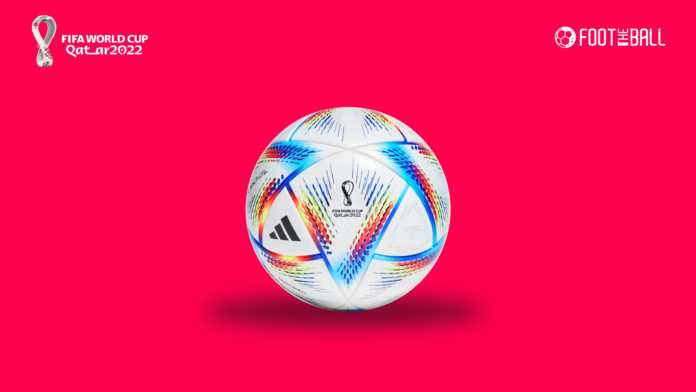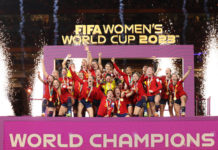In several of its earlier versions of the FIFA World Cup, many controversies propagated due to the lack of rules by FIFA at that time. The use of a match ball is one of them. Even in the first World Cup, the finalists Argentina and Uruguay, quarrelled over who among the two would provide the match ball for the final. This would end in 1970 when FIFA started choosing official balls for the tournament. Some of the tournaments would even have had multiple match balls.
Over the years, some of the match balls have acquired historical status and are still remembered vividly by fans ever after years, or sometimes decades. Meanwhile, others have failed to make a mark, with some like Jabulani causing a deep divide between players who either liked it or those who hated it.
However, the concept of match ball has remained in the World Cup with the one in Qatar named Al-Rihla. So, what is the history of FIFA World Cup match balls and their importance? We explain.
1930 World Cup Match Ball- Tiento and T-Model
The first World Cup final was held between Argentina and Uruguay. Both teams brought their ball for the final and clashed over which should be used. A compromise was reached eventually as the Argentinian ball (Tiento) was used in the first half while the Uruguayan ball (T-Model) was used in the second half.
1930 World Cup Final football #Uruguay pic.twitter.com/VaMph2sLvC
— LearnEnglishThroughFootball (@LETFootball) May 14, 2021
1934 World Cup Match Ball- Federale 102
Composed of 13 13 polygonal panels, which were cut and then sewn by hand, the Federale 102 was used in the 1934 World Cup. It was manufactured by Ente Centrale Approvvigionamento Sportivi (ECAS), Rome.
Modelo da bola utilizada na Copa do Mundo de 1934, na Itália.
O modelo da bola se chamava Federale 102#Football #WorldCup pic.twitter.com/83VnY4uH1W— Na Banheira (@_NaBanheira) June 18, 2020
1938 World Cup Match Ball- Allen
Allen was the match ball for the third FIFA World Cup in France. It was made up of leather which consisted of 13 panels and had a white cotton lace that separated the linen on the ball.
"Allen" 1938 World Championship
The third World Cup was held in France and it continued the practice of producing official balls by the country hosting the World Cup.https://t.co/YJNG3AXefT#NFT #Crypto #Ton #Airdrop pic.twitter.com/hPFI9TnoYJ
— Fans Club Sports (@fans_club_sport) October 2, 2022
1950 World Cup Match Ball- Duplo T
The World Cup didn’t take place for 12 years after 1938 due to the Second World War. So, for the first edition to be held since the war, the Duplo T was selected as the match ball. It was the first-ever ball that did not use laces and had a syringe valve.
4/22
Superball Duplo T
Brasil 1950This was the first world cup to use a valved ball rather than laced.
The poster design is by J Ney Damasceno. Little is known abouth him, the design being chosen through a competition. pic.twitter.com/5GGKJZ3dyN— Matchball Displays (@MatchballD) November 2, 2022
Rico Lewis: Newst gem to come out of Manchester City’s youth academy
1954 World Cup Match Ball- Swiss World Champion
The 1954 World Cup match ball was the Swiss World Champion. Manufactured by Kost Sport based in Basel, it was the first ever ball to use an 18-panel instead of the usual 13-panel.
5/22
Kost Sports – Swiss World Champion
Switzerland 1954As previously, the host country provided the balls for this tournament.
This design probably looks more like a modern football than world cup balls before.Poster by Swiss graphic designer Herbert Leupin pic.twitter.com/0P3fCycrZJ
— Matchball Displays (@MatchballD) November 3, 2022
1958 World Cup Match Ball- Top Star
The Top Star has had a unique story of being selected as the match ball for the 1958 FIFA World Cup. For the tournament, a total of 102 balls were considered. Still, the one made by Swedish manufacturer ‘Sydsvenska Läder- och Remfabriken” was selected after a blind test conducted by four FIFA officials. The ball had 18 panels and was available in three colours brown, orange and white.
⚽ FIFA World Cup Official Match Balls
🏆 Sweden 🇸🇪 1958 (Top Star)
🔸 #FIFA #World #Cup #Balls #Soccer #Mundial #Futbol #1958 #FIFAWorldCup #ECDTutoCMF #VamosPorMás pic.twitter.com/1oMa68rCou— Elcuadernodetuto (@ECDTuto) September 13, 2022
1962 World Cup Match Ball- Crack
The match ball controversies marred the 1962 World Cup in Chile. Several of the European teams were sceptical of the quality of the ball and thus several match balls were used, but the designated ball was the Crack made by the Senor Custodio Zamora H.
Shout out to the 1962 World Cup ball, which was called MR CRACK pic.twitter.com/5YLSkls2iM
— Adam Hurrey (@FootballCliches) November 9, 2017
1966 World Cup Match Ball- Challenge 4-Star
The 1966 FIFA World Cup was the first time an official mascot was used as World Cup Willie enthralled fans, especially after England won their first title. The official match ball used for the tournament was Challenge 4-Star which was an 18-panel ball available in orange and yellow colours. Just like the Top Star, it was selected after a blind test.
"Challenge 4-Star" 1966 World Championship
The Challenge 4-Star ball from the British company Slesinger, which was played at the World Cup in 1966, was similar to the Top Star model, sewn by hand, differing only in color. https://t.co/YJNG3AXefT#NFT #Crypto #Ton #Airdrop pic.twitter.com/Wa20sgdP5m
— Fans Club Sports (@fans_club_sport) October 2, 2022
1970 World Cup Match Ball- Telstar
The first World Cup ever to have an official match ball sanctioned by FIFA. Named Telstar by its manufacturer Adidas, it was the first ball with 32-panel to be used at the tournament. The ball was available in three colours, black and white stripes, brown and white (called the Chile Durlast).
DID YOU KNOW 🤔
Telstar, introduced for 🇲🇽Mexico 1970, was the first-ever @adidas #WorldCup ball. The Telstar 18, the official match ball for 🇷🇺Russia 2018, evokes unforgettable memories of that tournament ⚽️😍 #WednesdayWisdom pic.twitter.com/SzHP9F67xu
— FIFA World Cup (@FIFAWorldCup) April 11, 2018
Best player in the best tournament: The history of FIFA Golden Ball and its winners
1974 World Cup Match Ball- Telstar Durlast
For the next edition, Adidas developed an improved version of the 1970 match ball called the Telstar Durlast. It was the first ball to have a Polyurethane coating that made it waterproof and made it sturdier with fewer scuffs and tears.
#Telstar Durlast was used as the official match ball of the 1974 FIFA World Cup in #WestGermanyhttps://t.co/ws0427okjw#omb #durlast #leather #football #soccer #collector #vintage pic.twitter.com/bKzG8urNSX
— Mex_Antique (@mex_antique) June 8, 2022
1978 World Cup Match Ball- Tango
The first ball of the Adidas Tango football family, the Tango Durlast, was the official match ball for the 1978 FIFA World Cup. The ball had twenty identical hexagonal panels and gave an impression of 12 circles around these hexagons through triads. Like the Telstar, Tango also had a waterproof coating and was made of genuine leather.
Tango 1978 World Cup ball. A thing of beauty. pic.twitter.com/ki1lTKNPaZ
— John Ludden (@johnludds) October 9, 2022
1982 World Cup Match Ball- Tango Espana
Adidas launched an improved version of the 1978 World Cup ball in the next ball called the Tango Espana. Like the original Tango, it was made from genuine leather and had better waterproofing. However, the changes were not durable, and multiple balls had to be used in a single match. Due to this, FIFA decided never to use actual leather balls in the tournament again.
Tango España, 1982 FIFA World Cup Ball. pic.twitter.com/5bnVDJIwsJ
— Mark Farina (@djmarkfarina) March 15, 2021
1986 World Cup Match Ball- Azteca
After the disappointment of Tango Espana, Adidas came up with the first fully synthetic football in the 1986 FIFA World Cup. Named the Azteca, it was hand sewn and had 32 panels in white and black stripes.
The Match Ball for the 1986 FIFA World Cup revolutionized footballs and football production techniques. The #Adidas #Azteca was the first ever synthetic FIFA World Cup football . pic.twitter.com/Rz44Pd48DO
— FootballRetroPlus (@robertmdaws) May 23, 2022
1990 World Cup Match Ball- Etrusco Unico
The Etrusco Unico is one of the most successful balls made by Adidas. Apart from the 1990 FIFA World Cup, it was also used in the 1991 Copa America, the UEFA Euro 1992, and the 1992 Summer Olympics. The Etruscan civilisation inspired the design, whose symbol lion was engraved on each of its 20 triads. In addition, it had an inner layer of black polyurethane foam.
14/22
Italy 1990
Adidas Etrusco Unico (Euro 92 version)Adidas continued the host country theme on the tango panels with the Etrusco Unico. Three Etruscan style lions heads made up the Tango template.#italia90 #worldcup #worldcup90 #adidas #adidasfootball #adidasoriginals pic.twitter.com/ewR5vXvJX5
— Matchball Displays (@MatchballD) November 12, 2022
1994 World Cup Match Ball- Questra
Used in the 1994 FIFA World Cup and 1996 Summer Olympics. Euro 1996, and La Liga, the Adidas Questra remains one of the most revolutionary footballs ever to be created. Adidas used five different materials to make the ball more waterproof, lighter, softer and more responsive. This allowed players, especially the attackers, to move the ball quickly and at their will, though some goalkeepers were not amused with the ball. In addition, Questra had a space-themed decoration to commemorate the 25th anniversary of Apollo 11’s moon landing.
Adidas Questra official match ball of World Cup 1994 pic.twitter.com/duepaJ0XMa
— FootballRetroPlus (@robertmdaws) November 24, 2021
Luka Sucic: Young star is Croatia’s secret weapon in World Cup
1998 World Cup Match Ball- Tricolore
Adidas Tricolore was the first ever multi-coloured football to be used at a FIFA World Cup when it was unveiled in 1998. The ball was inspired by the design of the 1978 Tango and had blue triads decorated with the images of a cockerel, France’s national symbol. And the TGV, France’s high-speed train.
2002 World Cup Match Ball- Fevernova
The 2002 FIFA World Cup was the first of the new millennium and the first to be held in Asia, with Fevernova being the official match ball. It was made of 11 different layers, with the outer layer comprised of polyurethane and rubber. To improve the ball playing, Adidas added a layer of synthetic foam which helped make the ball lighter. In addition, the ball was decorated with dark gold trigon and a red streak which resembles calligraphy brush strokes showcasing the culture of South Korea and Japan.
Added Classic World Cup Balls in #FIFA23 via Title Update #2 🔥❤️
adidas Tricolore 1998 & adidas Fevernova 2002 pic.twitter.com/pbXwMmbTCV
— ReFIFA (@_ReFIFA) October 17, 2022
2006 World Cup Match Ball- Teamgeist
For the second-ever World Cup in Germany, Adidas’s home country the sports giant came up with the Teamgeist. It had 14 curved panels making the ball topologically equivalent to a truncated octahedron. It was the first World Cup where each match featured a unique ball with the name of the stadium, the date of the match being, the teams playing and the kick-off time inscribed on them.
For the final between Italy and France, Adidas unveiled a special version called the +Teamgeist which was similar to Teageist but was instead decorated with gold, black and white details.
The iconic 2006 Teamgeist is the only acceptable entry for the greatest World Cup ball of all time. Simply the best. pic.twitter.com/8e9bswq2CL
— Amos Murphy (@AmosMurphy_) March 30, 2022
2010 World Cup Match Ball- Jabulani
No other World Cup official ball has courted more controversy than the Jabulani. Made for the 2010 World Cup in South Africa, Jabulani had eight spherically moulded panels for better aerodynamics. It was made using 11 different colours, representing the 11 players in the football team, 11 languages of South Africa, and 11 communities in South Africa.
However, the ball faced severe criticism from several players. Lionel Messi, Julio Cesar, Gianluigi Buffon, David James, Joe Hart, Giampaolo Pazzini, Claudio Bravo, and Iker Casillas were among the many players who were not happy with the ball. Brazilian striker Robinho said, “For sure, the guy who designed this ball never played football. But there is nothing we can do; we have to play with it.” However, it found support from players such as Kaka, Michael Ballack, Clint Dempsey, Alvaro Arbeloa, and Frank Lampard. A special variant of the ball decorated with golden colour was used for the final.
With the World Cup around the corner, let's take a moment to remember this legend from 2010 👀
Which goal scored by the Jabulani first comes to mind? ☄️#WorldCup2022 #Football pic.twitter.com/Cdmygvauk1
— Two Halves Media (@TwoHalvesMedia_) November 5, 2022
Garang Kuol: Australia’s brightest talent is ready to dazzle in Qatar
2014 World Cup Match Ball- Brazuca
The Adidas Brazuca was the official match ball for the 2014 FIFA World Cup. It was the first time in the tournament’s history that fans in online voting selected the name of the match ball. As a result, Brazuca was chosen ahead of names such as Bossa Nova and Carnavalesca. The ball is composed of six polyurethane panels joined together by heating. This allowed the ball to have greater consistency and avoid the aerodynamic problems that its predecessor, Jabulani, had.
Blue, green, red, white and black colours were used to design the ball. The ball for the final between Germany and Argentina was called the Brazuca Final Rio, which used green, gold and black colours.
World Cup 2014 in Brazil:
Ochoa incredible saves.
RVP's iconic flying header.
Klose all-time WC topscorer.
Krul's penalty shootout role.
Götze wins Germany the World Cup in Et
🇧🇷 1-7 🇩🇪
James 's Puskas Award goal.
The "Brazuca" ball.One of the best World Cup editions ever.❤️🇧🇷 pic.twitter.com/sIuHfEyPEl
— Football Factly (@FootballFactly) November 22, 2019
2018 World Cup Match Ball-Telstar 18
For the 2018 FIFA World Cup in Russia, Adidas returned to Telstar, their first-ever ball in the tournament in 1970. Telstar 18 had six panels glued together. The ball also had an NFC chip embedded in it. However, the ball was also criticised, especially by goalkeepers such as Marc Andre Ter Stegen, David de Gea and Pepe Reina. According to critics, the ball changed direction unpredictably in the air, much like the Jabulani.
For the knockout matches, Adidas released a special edition called the Telstar Mechta, similar to Telstar, with the only difference being the colour they used.
Nov 9th: The official match ball for the 2018 World Cup is revealed at a ceremony in Moscow in 2017. The ball, designed & manufactured by Adidas, was named the Telstar 18 & was revealed at the presentation by the winner of the Golden Ball at the 2014 World Cup, Lionel Messi. pic.twitter.com/ViLuhkI1dF
— FIFA World Cup On This Day… (@FIFAWCOnThisDay) November 9, 2022
2022 World Cup Match Ball- Al Rihla
The name of the ball that will be used for the Qatar World Cup is called Al-Rihla, which means journey in Arabic. It will be the first time in the World Cup that water-based glues and inks will support the message of sustainability. In addition, al-Rihla has a textured PU skin with a new 20-piece panel shape. This allows the ball to have the accuracy, flight stability and swerve. In addition, FIFA says that the ball will allow for fast pace games that will make the matches more entertaining.




